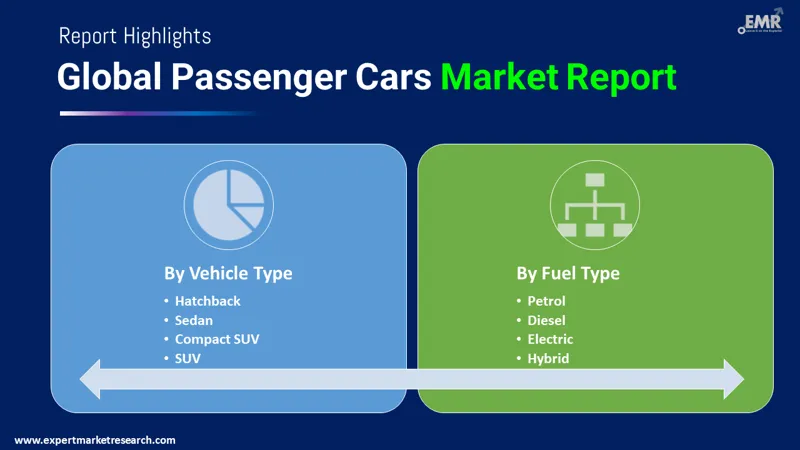
Consumer Insights
Uncover trends and behaviors shaping consumer choices today
Procurement Insights
Optimize your sourcing strategy with key market data
Industry Stats
Stay ahead with the latest trends and market analysis.
The global passenger cars market size reached a value of around USD 1.73 Trillion in 2025. The market is further expected to grow at a CAGR of 6.50% between 2026 and 2035, reaching a value of around USD 3.25 Trillion by 2035.
Base Year
Historical Period
Forecast Period
Compound Annual Growth Rate
6.5%
Value in USD Trillion
2026-2035
*this image is indicative*
| Global Passenger Cars Market Report Summary | Description | Value |
| Base Year | USD Trillion | 2025 |
| Historical Period | USD Trillion | 2019-2025 |
| Forecast Period | USD Trillion | 2026-2035 |
| Market Size 2025 | USD Trillion | 1.73 |
| Market Size 2035 | USD Trillion | 3.25 |
| CAGR 2019-2025 | Percentage | XX% |
| CAGR 2026-2035 | Percentage | 6.50% |
| CAGR 2026-2035 - Market by Region | Asia Pacific | 7.5% |
| CAGR 2026-2035 - Market by Country | India | 8.6% |
| CAGR 2026-2035 - Market by Country | UK | 5.9% |
| CAGR 2026-2035 - Market by Vehicle Type | SUV | 7.4% |
| CAGR 2026-2035 - Market by Fuel Type | Electric | 11.7% |
| Market Share by Country 2025 | France | 3.1% |
Passenger cars are four-wheeled motor vehicles that are primarily used to transport people. Since they are a common form of transportation, the number of passenger cars is growing in many nations. The size and shape of passenger cars may vary, as can the primary fuel source, however, most passenger cars have a total minimum seating capacity of five people, including the driver.

Read more about this report - REQUEST FREE SAMPLE COPY IN PDF

Read more about this report - REQUEST FREE SAMPLE COPY IN PDF
The EMR’s report titled “Passenger Cars Market Report and Forecast 2026-2035" offers a detailed analysis of the market based on the following segments:
Market Breakup by Vehicle Type
Market Breakup by Fuel Type
Market Breakup by Region
| CAGR 2026-2035 - Market by | Country |
| India | 8.6% |
| UK | 5.9% |
| USA | 5.8% |
| Germany | 5.4% |
| China | 4.8% |
| Canada | XX% |
| France | XX% |
| Italy | XX% |
| Japan | 4.5% |
| Australia | XX% |
| Saudi Arabia | XX% |
| Brazil | XX% |
| Mexico | XX% |
The SUV vehicle type is anticipated to witness significant growth in the market for passenger cars during the forecast period, owing to strong engines and features like sunroof and connected technologies. Due to the increasing global popularity of leisure and travel activities, there has been a growth in the demand for special utility vehicles (SUVs). In addition, the growing consumers preference for cars with a high stance and good road visibility is accelerating the segment growth.
Based on fuel type, the electric segment is estimated to have account for a sizable share in the passenger cars market in the coming years, supported by the growing infrastructure development for charging electric vehicles across many nations. Vehicles fuelled by petrol and diesel are expected to be increasingly replaced with hybrid and electric models due to their sustainability. Furthermore, the working population is switching significantly to electric-powered vehicles as a result of the rising fuel prices, thus aiding the growth of electric passenger cars.
The comprehensive EMR report provides an in-depth assessment of the market based on Porter's five forces model, along with giving a SWOT analysis. The report gives a detailed analysis of the following key players in the global passenger car market, covering their competitive landscape and the latest developments like mergers, acquisitions, investments, and expansion plans.
Mercedes-Benz AG, founded in 1998 and headquartered in Stuttgart, Germany, is one of the top manufacturers and suppliers of premium and luxurious vehicles and vans worldwide. The company develops, produces, distributes, and sells a variety of automotive products, including buses, trucks, vans, and passenger automobiles.
Ford Motor Company, established in 1903 and based in Michigan in the United States is one of the leading automakers that offers a complete line-up of cars, trucks, sport utility vehicles, and electric vehicles. The company also provides auto finance and leasing services.
Nissan Motor Co,Ltd, founded in 1933 and headquartered in Yokohama, Japan, is a major automaker with operations all over the world. The company produces and sells vehicles and related parts. It makes commercial vehicles, sports automobiles, luxury cars, and more.
*Please note that this is only a partial list; the complete list of key players is available in the full report. Additionally, the list of key players can be customized to better suit your needs.*
Other market players include General Motors Company, Volkswagen Aktiengesellschaft, Toyota Motors Corporation, Bayerische Motoren Werke AG, Honda Motor Co, Ltd, Tesla, and Kia Corporation, among others.




*While we strive to always give you current and accurate information, the numbers depicted on the website are indicative and may differ from the actual numbers in the main report. At Expert Market Research, we aim to bring you the latest insights and trends in the market. Using our analyses and forecasts, stakeholders can understand the market dynamics, navigate challenges, and capitalize on opportunities to make data-driven strategic decisions.*
Get in touch with us for a customized solution tailored to your unique requirements and save upto 35%!
In 2025, the global market for passenger cars attained a value of USD 1.73 Trillion.
The market for passenger cars is projected to grow at a CAGR of 6.50% between 2026 and 2035.
The market is estimated to witness healthy growth in the forecast period of 2026-2035 to reach USD 3.25 Trillion by 2035.
The major drivers of the market include the surge in middle-income group population, rising disposable income, increasing demand for passenger electric vehicles (EVs), and rise in standards of living.
Growing affordability of passenger cars, rise in technological advancements, and increasing urbanisation are the key trends propelling the growth of the market.
The major regions in the market are North America, Europe, the Asia Pacific, Latin America, and the Middle East and Africa.
The primary vehicle types in the market for passenger cars are hatchback, sedan, compact SUV, and SUV.
The major players in the passenger cars market are General Motors Company, Volkswagen Aktiengesellschaft, Toyota Motors Corporation, Mercedes-Benz AG, Ford Motor Company, Bayerische Motoren Werke AG, Honda Motor Co, Ltd, Tesla, Kia Corporation, and Nissan Motor Co,Ltd, among others.
Explore our key highlights of the report and gain a concise overview of key findings, trends, and actionable insights that will empower your strategic decisions.
| REPORT FEATURES | DETAILS |
| Base Year | 2025 |
| Historical Period | 2019-2025 |
| Forecast Period | 2026-2035 |
| Scope of the Report |
Historical and Forecast Trends, Industry Drivers and Constraints, Historical and Forecast Market Analysis by Segment:
|
| Breakup by Vehicle Type |
|
| Breakup by Fuel Type |
|
| Breakup by Region |
|
| Market Dynamics |
|
| Competitive Landscape |
|
| Companies Covered |
|
Single User License
One User
USD 3,999
USD 3,599
tax inclusive*
Datasheet
One User
USD 2,499
USD 2,249
tax inclusive*
Five User License
Five User
USD 4,999
USD 4,249
tax inclusive*
Corporate License
Unlimited Users
USD 5,999
USD 5,099
tax inclusive*
*Please note that the prices mentioned below are starting prices for each bundle type. Kindly contact our team for further details.*
Flash Bundle
Small Business Bundle
Growth Bundle
Enterprise Bundle
*Please note that the prices mentioned below are starting prices for each bundle type. Kindly contact our team for further details.*
Flash Bundle
Number of Reports: 3
20%
tax inclusive*
Small Business Bundle
Number of Reports: 5
25%
tax inclusive*
Growth Bundle
Number of Reports: 8
30%
tax inclusive*
Enterprise Bundle
Number of Reports: 10
35%
tax inclusive*
How To Order

Select License Type
Choose the right license for your needs and access rights.

Click on ‘Buy Now’
Add the report to your cart with one click and proceed to register.

Select Mode of Payment
Choose a payment option for a secure checkout. You will be redirected accordingly.
Gain insights to stay ahead and seize opportunities.

Get insights & trends for a competitive edge.

Track prices with detailed trend reports.

Analyse trade data for supply chain insights.

Leverage cost reports for smart savings

Enhance supply chain with partnerships.

Connect For More Information
Our expert team of analysts will offer full support and resolve any queries regarding the report, before and after the purchase.
Our expert team of analysts will offer full support and resolve any queries regarding the report, before and after the purchase.
We employ meticulous research methods, blending advanced analytics and expert insights to deliver accurate, actionable industry intelligence, staying ahead of competitors.
Our skilled analysts offer unparalleled competitive advantage with detailed insights on current and emerging markets, ensuring your strategic edge.
We offer an in-depth yet simplified presentation of industry insights and analysis to meet your specific requirements effectively.
Share